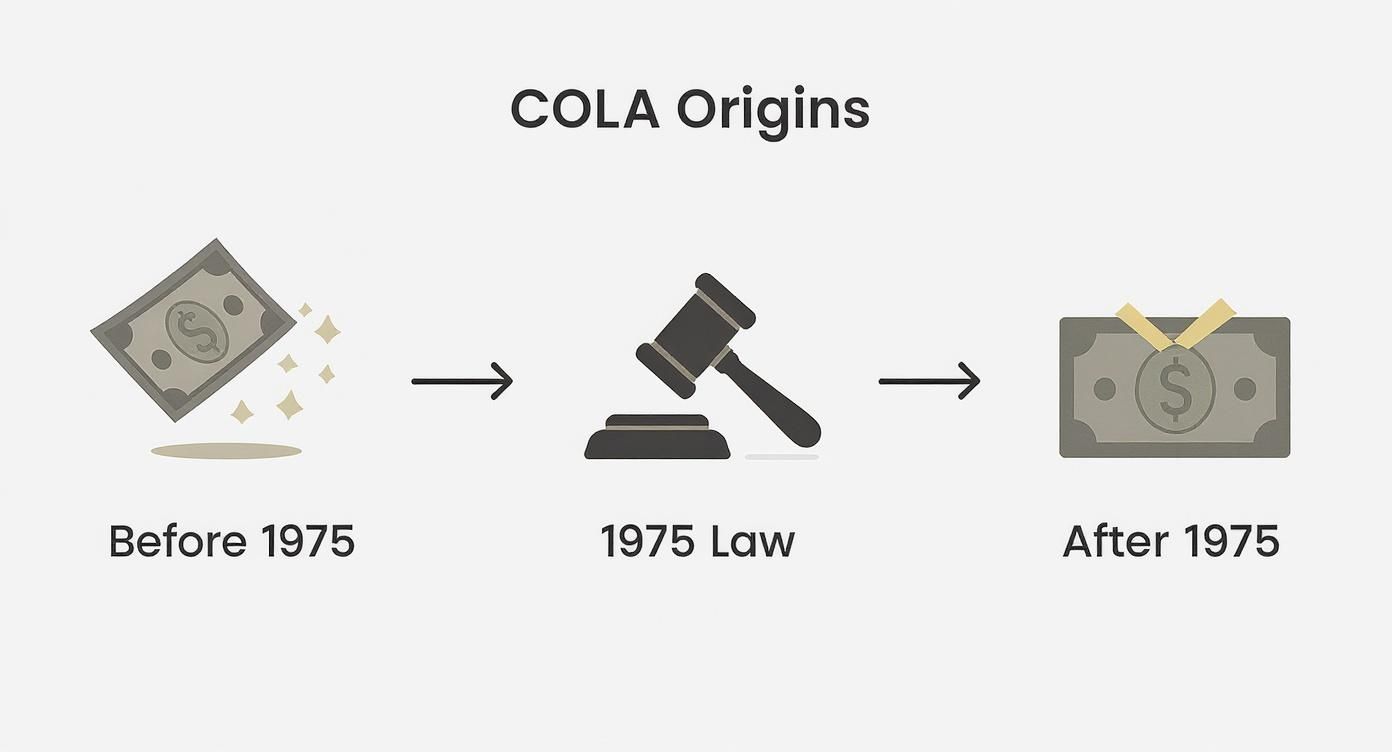Our Marketing Team at PopaDex
what is cost of living adjustment: Quick tips and impacts

A Cost of Living Adjustment, or COLA, is a bump in your income designed to help you keep up with inflation. It’s not a bonus or a raise for a job well done. Instead, think of it as a crucial financial adjustment that helps your salary, pension, or Social Security benefits match the rising prices of everything from groceries to gas.
The goal is simple: to maintain your purchasing power. It ensures the money you have today can buy roughly the same amount of stuff tomorrow.
What a COLA Really Means for Your Wallet

Imagine your income is a boat and inflation is a slowly rising tide. If your boat just sits there, you’ll eventually be underwater. A COLA is what lifts your boat along with the tide, keeping your financial head above water.
Its sole purpose is to stop your income’s real value from eroding over time. It’s purely a maintenance tool.
A COLA is a vital part of how programs like Social Security deliver on their mission to provide a foundation of security, ensuring benefits reflect today’s economic realities.
For a quick overview, here’s a breakdown of what a COLA is all about.
COLA Key Concepts at a Glance
| Concept | Simple Explanation |
|---|---|
| Purpose | To counteract inflation and maintain your purchasing power. |
| What It Is | An increase in income (like salary or benefits) tied to inflation rates. |
| What It Isn’t | A merit-based raise, a bonus, or a reward for performance. |
| Trigger | Usually an official inflation metric, like the Consumer Price Index (CPI). |
| Common Use Cases | Social Security benefits, federal pensions, and some private-sector salaries. |
This table gets to the heart of it, but there’s more to the story.
So, when you hear the Social Security Administration announce a 3.2% COLA, it means recipients’ monthly checks will increase by that percentage to help them cover higher living costs. This guide will demystify how these adjustments work, where they come from, and what they really mean for your budget. We’ll explore:
- The origins of COLAs and why they were created in the first place.
- How the government calculates the inflation numbers that drive these changes.
- The key difference between a COLA and a standard pay raise.
- Practical ways this impacts your personal financial planning and budgeting.
Why Were COLAs Created?
To really get why a Cost of Living Adjustment (COLA) is so important, you have to imagine a world without it. Before the 1970s, that was the reality for retirees and anyone else living on a fixed income—they were completely at the mercy of the economy.
If inflation shot up, the actual value of their monthly checks would nosedive. A pension that felt comfortable one year might barely cover groceries just a few years later. This wasn’t a small problem; it created real financial hardship for millions of vulnerable people.
Protecting Purchasing Power
The wild economic swings of the 1970s pushed this issue to a breaking point. With inflation soaring into the double digits, the fixed incomes that millions of Americans depended on were getting weaker by the day. It was a full-blown crisis, and lawmakers knew they needed a real, systemic fix.
The solution was a game-changer. The Cost of Living Adjustment (COLA) was officially rolled out in the United States in 1975, specifically to shield Social Security and Supplemental Security Income (SSI) beneficiaries from the crushing effects of inflation.
This single change introduced an automatic, yearly review of benefits. It created a direct link between payments and a key measure of inflation, ensuring that people’s income would rise in step with the cost of goods and services. Before this, any increase required a special act of Congress, which was slow, political, and totally unreliable.
The automatic COLA turned a messy, reactive process into a predictable financial safeguard. It brought stability where there was uncertainty, ensuring the purchasing power of seniors and other recipients was no longer left up to chance. You can learn more about how COLA legislation originated from Deel.com. It was a critical backstop then, and it remains just as essential today.
How a COLA Is Calculated
A Cost of Living Adjustment isn’t just some number pulled out of thin air. It’s the result of a very specific calculation designed to measure how inflation is actually hitting our wallets. The main tool for this job is the Consumer Price Index (CPI), an economic yardstick managed by the Bureau of Labor Statistics.
Think of the CPI as a massive, nationwide shopping cart. It’s filled with a standard “basket” of goods and services that represent what typical households buy—everything from milk and bread to gasoline and rent. By tracking the total cost of this basket over time, economists get a pretty accurate read on inflation.
The Specific Index Matters
Now, here’s where it gets interesting. Not all CPIs are the same, and the one that gets used depends on who the COLA is for. This is a critical distinction because it determines how different groups get their pay or benefits adjusted.
- CPI-W (Consumer Price Index for Urban Wage Earners and Clerical Workers): This index zooms in on the spending habits of households where at least half the income comes from clerical or wage-paying jobs. It’s the official metric used to calculate the annual COLA for Social Security and federal retirement benefits.
- CPI-U (Consumer Price Index for All Urban Consumers): This one is much broader, covering about 93% of the total U.S. population. Because it’s so comprehensive, many private companies and union contracts will reference the CPI-U when figuring out their own salary adjustments.
So, how does the government do the math for Social Security? They compare the average CPI-W from the third quarter (July, August, September) of the current year to the average from the same three months of the previous year. The percentage change between those two numbers becomes the official COLA for the next year.
For instance, to set the 2025 COLA, the Social Security Administration would look at the average CPI-W from Q3 2024 and compare it to Q3 2023. If that comparison showed a 2.5% increase, then that’s the adjustment beneficiaries would see in their checks.
This infographic really captures how the automatic COLA, introduced back in 1975, brought much-needed stability to the whole system.

Before this law, adjustments were sporadic and subject to political whims. This change created a reliable, automatic mechanism tied directly to real economic data, taking the guesswork out of it for millions of retirees.
COLA in the Real World
Now that we have the mechanics down, let’s talk about where you’ll actually run into a Cost of Living Adjustment. While the concept can feel a bit academic, its real-world applications are tangible and affect millions of people, from retirees to corporate employees. It’s a versatile financial tool, popping up in more places than you might think.
The most visible example is, without a doubt, Social Security. For over 70 million Americans, the annual COLA announcement is a major financial event that directly impacts their monthly income. Over the last two decades, these adjustments have hovered around 2.6% on average. But they can swing wildly—the 2.5% bump for 2025 feels small compared to the massive adjustments of over 8.5% during the high-inflation years of 2022 and 2023. You can explore more about payroll and compensation trends on peoplemanagingpeople.com.
Private Sector and Relocation Adjustments
It’s not just a government thing. Many private companies use a form of COLA, though it often goes by a different name or is applied in a specific context. One of the most common scenarios is when an employee relocates to a city with a much higher (or lower) cost of living.
For instance, if your company asks you to move from Omaha to San Francisco, they might offer a salary adjustment to offset the sticker shock. This isn’t a performance-based raise; it’s a practical bump to ensure your purchasing power doesn’t take a nosedive in your expensive new home. If you’re weighing a move, figuring out what your salary should be is critical. A salary equivalent calculator can give you a much clearer picture of what to expect.
Union Contracts and Pensions
COLAs are also a bedrock of many labor agreements and pension plans. They’re all about protecting the long-term financial security of workers and retirees.
- Union Contracts: Labor unions often fight to get COLA clauses written directly into their contracts. These provisions automatically trigger wage increases tied to inflation, preventing the negotiated pay rates from losing value as prices rise.
- Public Employee Pensions: Pension plans for teachers, firefighters, and other public servants frequently include an annual COLA. This is crucial for ensuring that a fixed pension payment doesn’t get eaten away by inflation over a retirement that could last decades.
A COLA clause in a contract acts as a financial shield. It’s a pre-negotiated agreement that worker wages won’t fall behind the general cost of living, providing predictable stability for employees and their families.
So, how does this all stack up? While the goal is the same—protecting purchasing power—the application can look quite different depending on the sector.
How COLA Is Applied Across Different Sectors
Here’s a comparative look at how COLA is applied with typical adjustment ranges.
| Sector | Common Application | Typical Range |
|---|---|---|
| Federal Government | Annual adjustment for Social Security & federal pensions. | Varies with CPI-W; historically 1-8%. |
| Private Corporations | One-time salary adjustment for geographic relocation. | Highly variable; based on city-to-city cost difference. |
| Unionized Labor | Contractually mandated annual wage increase. | Often capped; typically 2-4% annually. |
As you can see, a COLA isn’t a one-size-fits-all solution. Its structure and impact are shaped by whether it’s part of a federal mandate, a corporate policy, or a hard-won labor negotiation.
Understanding COLA Versus a Merit Raise
It’s one of the most common points of confusion when talking about pay: is a cost-of-living adjustment the same as a raise? The short answer is no. While both mean more money hits your bank account, they serve completely different purposes.
Think of a COLA as a maintenance adjustment. It’s designed to help your salary tread water against the rising tide of inflation, preserving your current purchasing power. It has nothing to do with your performance on the job—it’s a broad adjustment based on economic shifts.
A merit raise, on the other hand, is a reward for your hard work and achievements. It’s about moving forward financially, not just keeping up. This is the pay bump that recognizes your specific skills, successes, and contributions to the company’s goals.
Why This Distinction Matters
Getting this difference is crucial for your career and financial planning. A COLA helps everyone stay afloat, but a merit raise is what helps you get ahead and actually build wealth. They serve two entirely separate functions.
- COLA (Preservation): Aims to ensure your income buys the same amount of groceries, gas, and goods as it did last year.
- Merit Raise (Advancement): Aims to increase your income and purchasing power in recognition of your value to the company.
While COLAs are a standard feature in government benefits, they’re also common in the corporate world, especially for employees on international assignments. Companies often use them to offset cost differences between locations, with typical adjustments in the U.S. hovering between 2% and 4% during periods of normal inflation. You can read more about how corporations apply COLAs on ADP.com.
A COLA is about economic reality; a merit raise is about personal value. One addresses the cost of living, while the other acknowledges your cost of leaving.
Knowing this helps you properly evaluate your total compensation. If your annual pay bump is only a COLA, your actual earning power isn’t growing at all. This is a critical piece of information when you compare your salary against what others in your field are making. Beyond COLAs, the other big pay change to watch for is a promotion; it’s worth learning what constitutes a good promotion salary increase percentage.
How COLAs Affect Your Personal Budget

So, how does all this talk about COLAs actually translate to your bank account? Let’s bring it home. When your salary or benefits get a Cost of Living Adjustment, it’s designed to help your budget absorb the rising costs of everyday essentials like gas, groceries, and rent.
Think of it as a financial shock absorber. As prices creep up, that COLA gives you a bit more cash flow to keep up without having to dip into savings or fall behind on bills. For a lot of people, it’s the buffer that keeps their financial plan from going off the rails.
But it’s important to keep expectations in check. A COLA isn’t a raise or a bonus—it rarely feels like you’re getting ahead. It’s built to maintain your current lifestyle, not upgrade it. That extra money just gets eaten up by the new, higher prices, so your actual purchasing power stays pretty much the same. You’re just breaking even.
The Hidden Catch of Bracket Creep
There’s another little wrinkle to be aware of called bracket creep. Because a COLA increases your gross income on paper, it can sometimes nudge you into a higher federal income tax bracket.
This means that even though your income went up to fight inflation, a larger slice of it might now be going to Uncle Sam. This can quietly eat away at the net benefit of your adjustment.
This is exactly why you need to look at your entire financial picture, not just the top-line numbers. Knowing your actual take-home pay after all taxes and adjustments is what really matters for budgeting. A great place to start is to calculate your disposable income to see what you truly have left to work with each month.
While a COLA helps you tread water, other financial strategies can help you swim forward. Smart approaches to investing during inflation can help your money not just keep pace with rising costs, but actually grow your wealth in the long run.
Common Questions About COLA, Answered
Let’s clear up some of the common questions people have about Cost-of-Living Adjustments. Think of this as your quick-and-dirty guide to understanding the details.
Is a COLA the Same Thing As a Raise?
Nope, and it’s a really important difference. A cost-of-living adjustment is just that—an adjustment. It’s meant to help your paycheck keep up with inflation so you don’t lose buying power. Think of it as maintenance for your income.
A merit raise, on the other hand, is a reward for doing great work. It’s based on your performance, skills, and value to the company. A raise is designed to actually increase your financial standing, not just help you tread water.
Are Employers Required to Give a COLA?
In most cases, no. Private companies in the U.S. generally have no legal obligation to offer a COLA. They’re mandatory for federal benefits like Social Security and are often baked into government and union contracts. For everyone else, it’s a company-by-company choice.
For private-sector jobs, a COLA is not a guaranteed benefit. It’s usually a strategic decision a company makes to attract and retain talent, or a key point negotiated in a union agreement.
Can a COLA Ever Be Negative?
It’s technically possible if we hit a period of deflation (where prices fall), but it’s incredibly rare in practice. Major programs like Social Security have rules in place to prevent this from happening.
If the CPI-W ever goes down, the COLA is simply set to 0% for that year. Your benefits won’t get cut; they just stay flat until inflation picks back up again. This acts as a safety net, ensuring your income doesn’t shrink.
Does a COLA Increase My Income Taxes?
Yes, it can. Since a Cost-of-Living Adjustment adds to your gross income, it’s taxed just like the rest of your pay. This extra income could bump you into a higher tax bracket, a phenomenon known as “bracket creep,” which might slightly eat into the net gain from the adjustment.
Take control of your financial big picture with PopaDex. Track every asset and liability in one place to see how adjustments like a COLA truly impact your net worth. Start your free trial today.